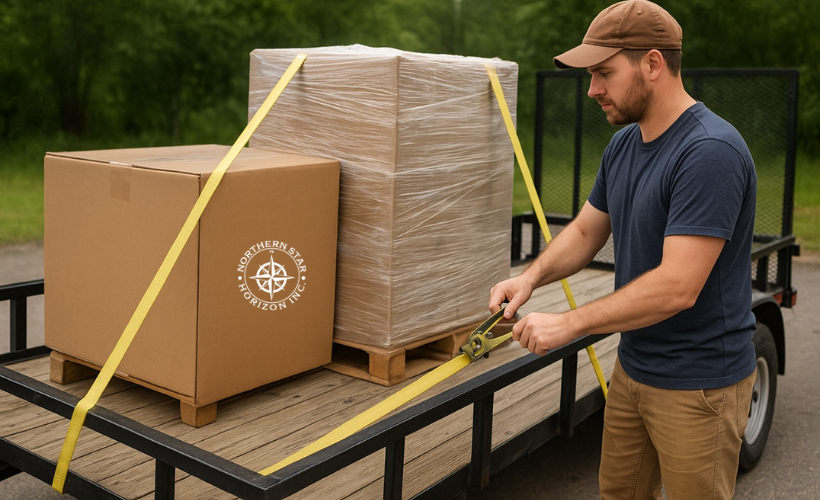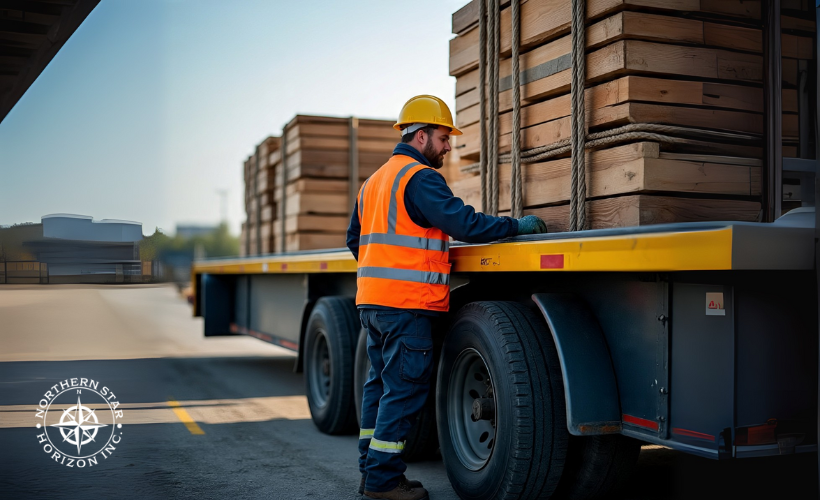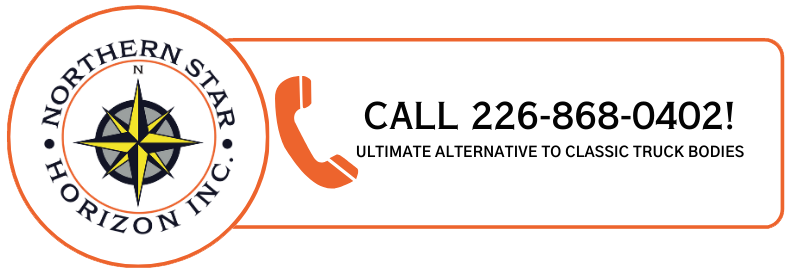How to Properly Secure Trailer Cargo – Complete Guide

Learning how to secure trailer cargo properly protects your investment, prevents accidents, and keeps you legal on Ontario roads. Whether you haul construction equipment, landscaping materials, or household items, proper cargo security saves time and money while ensuring everyone’s safety. Northern Star Trailers customers often ask about the best practices for load security, and this guide covers everything you need to know to secure trailer cargo like a professional.
Why Proper Cargo Security Matters
Unsecured loads cause thousands of accidents each year across Canada. Loose cargo can shift during transport, creating dangerous driving conditions and potentially causing your trailer to jackknife or roll over. Insurance companies may deny claims for damages caused by improperly secured loads, leaving you responsible for repair costs and liability.
Beyond safety concerns, Ontario’s Highway Traffic Act requires all loads to be properly secured. Police can fine drivers for unsecured cargo, and penalties increase significantly if loose items cause property damage or injuries. Professional contractors and landscapers know that proper load security protects their reputation and business relationships.
Secure cargo also prevents damage to your materials during transport. Construction supplies, landscaping equipment, and furniture can suffer costly damage from shifting and bouncing when not properly restrained. Taking time to secure your load correctly saves money on replacement costs and keeps projects on schedule.
Essential Equipment for Securing Trailer Loads
Quality tie-down equipment forms the foundation of cargo security. Ratchet straps provide the strongest and most reliable option for most loads. Choose straps with a working load limit rated for at least twice the weight of your cargo, and inspect them regularly for wear or damage. The working load represents the maximum safe weight your equipment can handle during normal use.
Chains work well for heavy equipment and machinery but require proper hooks and binders for safe use. Never use damaged chains, and always check weight ratings before loading. Rope and bungee cords should only secure light, non-critical items as they can stretch and loosen during transport.
Additional securing equipment includes:
- Corner protectors to prevent strap damage
- Load bars for cargo trailers
- Chocks and blocks for wheeled equipment
- Tarps for weather protection
- E-track systems for versatile anchor points
- Heavy-duty chains for machinery transport
Northern Star Trailers offers various trailer models equipped with built-in tie-down points, making cargo security easier and more effective for our customers.
Step-by-Step Cargo Securing Process
Start by planning your load distribution before loading any items. The type of cargo determines your securing strategy – evaluate each load’s weight, size, and shape before choosing equipment. Place heavy items low and centered in the trailer, distributing weight evenly from side to side and front to back. This prevents trailer sway and maintains proper tongue weight for safe towing with your tow vehicle.
Position cargo against the front wall of enclosed trailers when possible. This prevents forward movement during sudden stops and reduces stress on tie-down equipment. Leave space between items to allow proper strap placement and prevent damage from contact during transport.
Secure your load using the following process:
- Place primary restraints – Install ratchet straps or chains over the top of your cargo, pulling down at angles to prevent both vertical and horizontal movement
- Add side restraints – Use additional straps or blocking to prevent lateral shifting, ensuring anchor points can handle the working load
- Check strap tension – Tighten all straps firmly but avoid over-tightening, which can damage cargo or equipment
- Test the load – Gently rock the trailer to ensure nothing moves before departing
- Inspect frequently – Check tie-downs after the first few miles and regularly during long trips
Never rely on a single tie-down point for heavy items. Use multiple straps at different angles to create a web of restraint that prevents movement in all directions.
Common Mistakes to Avoid
Many people make the mistake of using too few tie-downs or placing them incorrectly. The general rule requires one tie-down for every 10 feet of cargo length, with a minimum of two tie-downs regardless of load size. Longer items like lumber or pallets need additional straps every 10 feet along their length, and each tie-down must comply with the working load requirements.
Avoid using damaged or undersized equipment. A broken strap or chain can cause catastrophic load failure, especially at highway speeds. Replace worn equipment immediately and never exceed weight ratings printed on straps or chains.
Another common error involves inadequate inspection during transit. Straps can loosen as cargo settles, especially during the first few miles of travel. Stop frequently on long trips to check and retighten tie-downs as needed. Professional haulers know that different types of cargo require specific attention during transport.
Weather conditions also affect load security during transit. Rain can make straps slippery and reduce friction between cargo and trailer surfaces. Wind increases stress on tall or lightweight loads, requiring additional securing measures for safe transport. Always ensure your tow vehicle’s brake system can handle the additional weight and stopping distance required.
Different Methods for Different Trailer Types
Cargo trailers offer the most options for securing loads with built-in tie-down points, wall anchors, and load bars. Chains and straps used to secure different types of cargo attach to these anchor points for maximum effectiveness. Use the trailer’s structure to your advantage by securing items to multiple points and preventing forward movement against the front wall.
Flatbed and utility trailers require different approaches since cargo remains exposed to weather and wind. Focus on creating downward pressure with multiple straps while also preventing lateral movement. Corner protectors become critical for preventing strap damage on sharp edges.
Dump trailers need special attention to prevent cargo from falling out during transport. Even with tailgates closed, items can shift and spill during unloading. Secure loose materials with tarps and ensure proper weight distribution to maintain trailer stability.
Equipment trailers often transport wheeled machinery that can roll if not properly blocked. Use wheel chocks, chains, and straps in combination to prevent both rolling and sliding. Northern Star Trailers equipment models include features specifically designed for securing heavy machinery safely.
Legal Requirements and Safety Standards
Ontario law requires all cargo to be secured to prevent falling, shifting, or becoming detached during normal driving conditions. This includes acceleration, braking, and turning at legal speeds. Operators must comply with these regulations and ensure their hitch and trailer combination can safely handle the intended load. Failure to properly secure loads can result in fines, liability for damages, and criminal charges if injuries occur.
Commercial operators face stricter regulations and higher penalties for cargo violations. Professional drivers must understand weight limits, securing requirements, and inspection procedures to maintain their licenses and insurance coverage.
The North American Cargo Securement Standard provides detailed guidelines for different cargo types. While primarily aimed at commercial operators, these standards offer excellent guidance for anyone transporting loads on public roads.
Document your securing methods with photos when transporting valuable or critical loads. This evidence can prove compliance with regulations and support insurance claims if problems occur despite proper procedures.
Maintenance and Inspection Tips
Regular equipment inspection prevents failures and extends the life of your securing hardware. Check ratchet straps for worn webbing, damaged ratchets, and bent hooks. Replace any equipment showing signs of wear or damage immediately.
Clean straps and chains after use, especially when exposed to salt, chemicals, or abrasive materials. Store equipment properly to prevent UV damage to webbing and corrosion of metal components. Proper storage extends equipment life and maintains strength ratings.
Keep detailed records of equipment purchases and replacement dates. This helps track usage patterns and plan replacement schedules before equipment fails. Professional operations maintain backup equipment to avoid delays from unexpected failures.
Train all drivers and operators on proper securing techniques and equipment inspection procedures. Consistent practices reduce accidents and ensure legal compliance across your organization.
Protect Your Investment with Professional Cargo Security
Proper cargo security protects your materials, your trailer, and everyone sharing the road with you. The techniques and equipment discussed in this guide help ensure safe transport while meeting legal requirements. Remember that taking time to secure your cargo correctly saves money on damages and prevents dangerous situations.
Northern Star Trailers provides quality trailers designed with proper tie-down points and securing features to make cargo security easier and more effective. Our team understands the challenges Ontario contractors and business owners face when transporting materials and equipment safely.
Contact Northern Star Trailers today to learn how our trailer solutions can improve your cargo security and transport efficiency while keeping your loads safe on every journey.
The post How to Properly Secure Trailer Cargo – Complete Guide appeared first on Northern Star Horizon.
source https://northernstartrailers.ca/secure-trailer-cargo-complete-guide/


Comments
Post a Comment